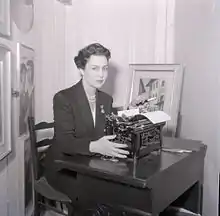Livia De Stefani
Livia De Stefani (23 June 1913 – 28 March 1991) was an Italian writer.
Livia De Stefani | |
|---|---|
 Livia De Stefani | |
| Born | 23 June 1913 Palermo |
| Died | 28 March 1991 (aged 77) Rome |
| Occupation | Writer |
| Notable work | The Vineyard of Black Grapes (1953) |
| Spouse | Renato Signorini |
| Relatives | Jacques Sernas (son-in-law) |
Early life
Livia De Stefani was born into a wealthy landowning family in Palermo, and educated at a convent.[1][2]
Career
In midlife, De Stefani began writing fiction, and published her novel La vigna di uve nere (1953, published in English as Black Grapes).[3] She went on to write a collection of three short stories, Gli affatturati (1955),[4] another collection of short stories, Viaggio di una sconosciuta (1963, Journey of an Unknown Woman), several more novels, Passione di Rosa (1958, The Passion of Rosa), La signora di Cariddi (1971, The Lady of Cariddi), and La Stella Assenzio (1975, The Star Absinthe),[5] and a memoir, La mafia alle mie (1991, The Mafia Behind Me).[2][6]
De Stefani's writing is known for its dark psychological themes[3][4][5] and its Sicilian cultural context, or sicilianità, including her descriptions of the 1968 Belice earthquake. She is sometimes described as "the first woman to write about the Mafia."[7]
De Stefani won the Premio Venezia in 1952 and the Premio Selento in 1953.[8] De Stefani's novel La vigne di uve nere was adapted for television in 1984. She appeared onscreen in the film Summer Night with Greek Profile, Almond Eyes and Scent of Basil (1986). Her social circles included writers Elsa Morante, Maria Bellonci, and Vitaliano Brancati.[1]
Personal life
In 1930, De Stefani married sculptor Renato Signorini, and moved to Rome. They had three children; their daughter Maria Stella Signorini married actor Jacques Sernas.[9] Renato Signorini died in 1966.[2] De Stefani died in 1991.[10]
References
- Rizzo, Ester (2016). "Livia De Stefani". Enciclopedia delle donne (in Italian). Retrieved 2022-04-17.
- Wilson, Katharina M.; Wilson, M. (1991). An Encyclopedia of Continental Women Writers. Taylor & Francis. pp. 311–312. ISBN 978-0-8240-8547-6.
- Rosenthal, Raymond (April 20, 1958). "The Doors Are Barred". The New York Times. p. 126. Retrieved April 17, 2022 – via Times Machine.
- Langlois, Walter G. (1956). "Review of Gli affatturati". Books Abroad. 30 (2): 217. doi:10.2307/40095549. ISSN 0006-7431. JSTOR 40095549.
- Ross, Cecilia (1987). "Review of La Stella Assenzio". World Literature Today. 61 (1): 83–84. doi:10.2307/40142513. ISSN 0196-3570. JSTOR 40142513.
- Marrone, Gaetana; Puppa, Paolo (2006-12-26). Encyclopedia of Italian Literary Studies. Routledge. p. 1340. ISBN 978-1-135-45530-9.
- Rizzo, Ester (2020-08-07). "Livia De Stefani: la prima donna che scrisse di mafia". Vitamine vaganti (in Italian). Retrieved 2022-04-17.
- Ragusa, Olga (1959). "Women Novelists in Postwar Italy". Books Abroad. 33 (1): 5–9. doi:10.2307/40097650. ISSN 0006-7431. JSTOR 40097650.
- Rampino, Antonella (2014-04-14). "Quando la sera giocavamo a Via Veneto". La Stampa (in Italian). Retrieved 2022-04-17.
- Pickering-Iazzi, Robin (2007-01-01). Mafia and Outlaw Stories from Italian Life and Literature. University of Toronto Press. pp. 169–170. ISBN 978-0-8020-9561-9.